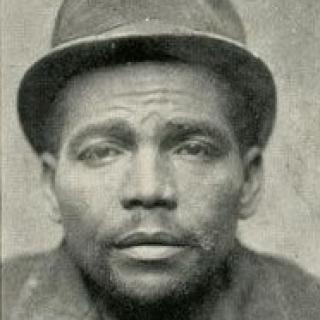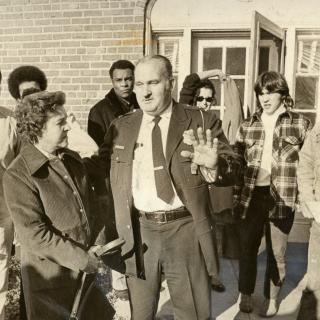The Mystery of the Pope's Stone
On the evening of March 5, 1854, nine men associated with the Know-Nothing party snuck up to the base of the Washington Monument and made off with a rather hefty hunk of stone. The men carried the stone to a boat waiting on the tidal basin, smashed it into pieces and dumped it in the middle of the Potomac.
You may be curious as to why they (or we!) were interested in an old — and probably really heavy — rock. Where exactly did this stone come from and why was it such a big deal when it was stolen and destroyed? Maybe it was the fact that it came from the Pope... Just a guess.
In 1833, the Washington National Monument Society put out a call for donations, either in money or stones, to aid in the building and decorating of the upcoming monument. “The request produced an odd assortment of almost 200 memorial stones that now adorn the inside walls of the monument for 400 of its 555 feet.”[1]
One of the most unique stones came to be known as the Pope’s Stone, a gift from Pope Pius IX and the Vatican. The three-foot slab of “costly variegated marbles” was originally from ruins of the Temple of Concord in Rome, built in 366 B.C. Engraved on the face of the stone were the words “From Rome.” This wasn’t your average rock.[2]
That’s probably why flocks of people were seen searching for fragments of the stone on the banks of the Potomac in the days after the heist. According to one account, “Five dollars an inch was offered for pieces of the genuine.”[3] There was also a $500 reward for information about the perpetrators.[4]
But, despite these incentives, no one was ever convicted of the crime. It would be almost 30 years before the story came out and even then there was a realm of secrecy. Perhaps that’s not too surprising considering the Know-Nothings were known for being very secretive in addition to being anti-immigrant and anti-Catholic.
In 1883, a man known only as "the saloon keeper" came forward to The Washington Post and described what happened to the stone.
Nine of us did the job on Sunday night, the 5th of March, 1854. We attended a meeting of the Know-nothing order, to which we all belonged, on the Tuesday night previous at Thorn’s hall, next door to the Odd Fellows hall on Seventh Street. There was a good deal of speaking going on about the shame of having a stone from any king or potentate inserted in the monument of a man who had found against royal tyranny, and finally it was agreed that nine men should be selected by lot to destroy the stone.
He detailed how the men had tied up the night watchman at gunpoint, rolled the stone to the river, and at the sight of a red lantern signal from co-conspirators stationed on the Long Bridge, pushed it over the side of the boat. The saloon keeper also mentioned that on the way to the river, many of the men had broken off small chunks of the stone to keep as prizes. “That’s the true story of the whole transaction,” he boasted and predicted that “if the dredges at work in the Potomac strike the right spot, they will fish up some thing that will create a sensation.”[5]
True to the saloon keeper’s word, the famous rock turned up in 1892 while divers were digging holes for new piers for Long Bridge. On his third trip down that day, diver Harry Edwards uncovered an interesting chunk of stone which he described as “a sharply cut and beautifully polished piece of variegated marble, striated in veins of pink and white.” He noticed a deep Gothic engraving, of which he could make out the letters “Ro- t- merica.” It was almost certainly the Pope’s Stone![6]
That would’ve made a tidy end to the story except that the stone, which authorities set aside for “safe keeping,” was stolen again a few days later.[7] Would it ever resurface again?
In 1972, a woman came forward with a unique donation to the Smithsonian. It was an 18-inch marble obelisk, supposedly carved from a fragment of the Pope’s Stone. Could it really be authentic? No one was quite sure, but the Smithsonian put it on display anyway.
The donor, Kathryn Wells, reported that she had kept the obelisk hidden in her closet for 60 years after receiving it as a gift from Joseph A. Ridgway, one of her neighbors in Upper Marlboro, Maryland. According to Wells, Ridgway (who, by the way, was a saloon keeper, himself) had received the obelisk from his brother who was supposedly one of the nine Know-Nothings who carried out the Pope’s Stone heist in 1854.
Hmmm… interesting.
At any rate, a new “Pope’s Stone” was commissioned by a priest in Spokane, Washington and installed in the monument by the National Park Service in 1982. Although it’s not the original, it’s a good stand-in and reminder of the mysterious mayhem, which began in 1854.[8]
Footnotes
- ^ Hodge, Paul. "Pope’s Stone Mystery: Is The Evidence in Smithsonian?." The Washington Post, June 1, 1978.
- ^ Ibid.
- ^ Jacob, Judith M. National Park Service-U.S. Department of Interior, "The Washington Monument: A Technical History and Catalog of the Commemorative Stones." p. 222 Last modified 2005. Accessed July 16, 2013.
- ^ "The Pope’s Stone: How the Pontiff’s Gift was Stolen and Sunk in the Potomac." The Washington Post, September 30, 1883.
- ^ Ibid.
- ^ "Romance on the River: The Potomac Gives Up Its Long Hidden Secrets." The Washington Post, June 19, 1892.
- ^ "Stole the Pope’s Stone: The Mysterious Tablet Disappears a Second Time." The Washington Post, June 21, 1892.
- ^ Jacob, Judith M. National Park Service-U.S. Department of Interior, "The Washington Monument: A Technical History and Catalog of the Commemorative Stones." p. 16 Last modified 2005. Accessed July 16, 2013.





![Sketch of the mythical fuan by Pearson Scott Foresman. [Source: Wikipedia]](/sites/default/files/styles/crop_320x320/public/2023-10/Goatman_Wikipedia_Faun_2_%28PSF%29.png?h=64a074ff&itok=C9Qh-PE1)












